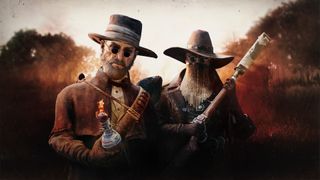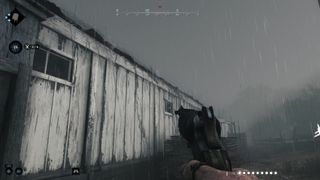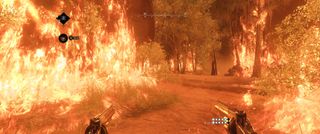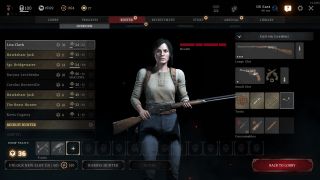After attracting more players than ever, Crytek isn't done breaking Hunt: Showdown: 'If nobody says don't do that, then it's not actually good enough'
Crytek talks balance, MMR, and breaking extraction shooter conventions in Hunt.

We're nearly three weeks into Hunt: Showdown's big Tide of Shadows event, an update that introduced rain to Hunt's already murky maps, a handful of intriguing guns, and a new miniboss that lives outside the confines of compounds. It's the largest update the game has seen since the De Salle map arrived two years ago, and has already helped it reach a new concurrent player milestone on Steam.
To mark the occasion, PC Gamer sat down with Hunt general manager David Fifield for an extensive Hunt chat. Below are excerpts from a 30-minute interview that covered the community's reaction to Tide of Shadows, rain, wildcard contracts, balance, pact traits, the future of MMR in Hunt, and more.
On the reception of Hunt's new rain maps
"The positive reaction to the rain itself is way better than I thought it'd be," Fifield said.
Tide of Shadows introduces a new rainstorm map condition that changes Hunt both visually and tactically. Longtime players used to relying on subtle sound cues to gain an advantage are currently stunted by the constant drum of rain and thunder. Beyond sound, rain means fog that limits visibility, explosive barrels that aren't reactive to fire, and drenched bodies that can't be burned to prevent a revive. Fifield says Crytek wasn't certain players would be on board with a map variant that forces these playstyle adjustments.
"There was a concern that ‘Hey, is it not gonna be as fun as people thought it would be, even though we really enjoyed testing it?'" he said. "So I'm surprised by how positive it's been and that it wasn't more mixed."
On Wildcard contracts and map balance
The positive reaction to the rain itself is way better than I thought it'd be.
David Fifield
Crytek is also trying something new with how the rain map condition is accessed. Players have to opt in to rain by selecting a special playlist before matchmaking. The aim of this, Fifield says, is to strike a better map balance than Hunt's previous Wildcard event: Inferno. The wildfire map variant was enjoyed during its limited availability, and in hopes of giving everyone a guaranteed chance to check it out, Crytek experimented with scheduled days in which Inferno was the only map variant in rotation.
"But then with that we pretty quickly started getting ‘Yea, that's enough Inferno,'" Fifield said.
The biggest gaming news, reviews and hardware deals
Keep up to date with the most important stories and the best deals, as picked by the PC Gamer team.
Fifield believes map balance "feels pretty good as it is" with Tide of Shadows' separate playlist, but acknowledges that it's still not pleasing everybody. Some players aren't happy that night maps are mixed into the rain playlist. Getting a clear-sky night match when you were hoping for the new rain can be a bummer.
"That frequency of map rotation, the frequency of a thing that everybody wants to see but nobody wants to see 100% of the time, that's the big thing we've been wrestling with."

On breaking Hunt with powerful traits
Returning in Tide of Shadows is the pact system that grants players extra powerful traits that, on the surface, sound like they'd break Hunt's balance. Fifield says that, to a degree, that's intentional.
"One of our litmus tests, even amongst ourselves, when we propose one of these new traits is if nobody says ‘don't do that,' then it's not actually good enough," Fifield said.
It's not gonna be fun or interesting if it's so subtle as to not be talked about.
David Fifield
While pact traits are tested for balance before release, Fifield says part of their purpose is to tweak Hunt's fundamental rules and discover opportunities to change the game for the better. Often, that means trying something out that immediately seems overpowered.
"There's a goal with some of these that at first they should sound OP, but then when we actually get it balanced it's like, ‘Yea, that's not actually OP,'" Fifield said.
Players tend to lower their alarm level, Fifield says, once they learn how to counter a new ability or discover it's not as powerful as they imagined. I had a similar reaction when Crytek first unveiled the Stalker Beetle, a remote-controlled bug drone—unlimited sky surveillance sounded like a disruptive new variable to Hunt's tactical ecosystem, but its effect on the meta proved minor.
And regarding pact traits:
"It's temporary. So we'll walk it back, we'll tune it. We'll keep going forward with the ones that made the games more fun and interesting, but it's not gonna be fun or interesting if it's so subtle as to not be talked about."
We've seen that philosophy in action with the permanent introduction of self-revive for solo players earlier this year, an update to the Necromancer trait first tested during the Devil's Moon event.

On MMR and balance in an extraction shooter
Fifield also touched on Hunt's skill-based matchmaking. Hunt's 1-6 star MMR system is determined by your kill/death ratio weighted against the skill of the players you fight. The result is a fluid hierarchy where your rank can move up or down in a single session. Your group MMR is the average skill rating of your party, so it's not uncommon to fight players that are higher or lower ranked than you.
"There's one way to look at MMR, which is to say that ‘I'm a 4 [star] and I went into this game and got killed by a 6 [star].' One person can look at that and think ‘I don't feel bad, I got killed by a 6 [star]. I didn't expect to dunk on Michael Jordan,'" Fifield said. "But then there's another way that's ‘How on earth could you put me on the court with Michael Jordan!' Most people are gonna have that second reaction."
Fifield also talked about how the community's perception of MMR can differ from how it's meant to be interpreted, and clarified that Hunt's current systems aren't set in stone.

"All it really reflects is your frequency of success. It isn't even to say you're a better shot or a better player, or anything," Fifield says. "But then some people want it to be more like a [traditional ranking], like Bronze, Silver, Gold, Platinum, Onyx. And because we don't have that ranked system, they glom onto MMR. And when you make that the end-all-be-all goal, if everyone is saying you should play to be a 6-star, that's when players say it makes people play in an unfun way—camping with snipers in bushes, not engaging with the game, watching Netflix while they wait for a victim….All because they've perceived that the goal should be ‘get to 6 stars.'
"Those are things we do talk about, and those are not things I'd say are permanent in Hunt."

Morgan has been writing for PC Gamer since 2018, first as a freelancer and currently as a staff writer. He has also appeared on Polygon, Kotaku, Fanbyte, and PCGamesN. Before freelancing, he spent most of high school and all of college writing at small gaming sites that didn't pay him. He's very happy to have a real job now. Morgan is a beat writer following the latest and greatest shooters and the communities that play them. He also writes general news, reviews, features, the occasional guide, and bad jokes in Slack. Twist his arm, and he'll even write about a boring strategy game. Please don't, though.
- Evan LahtiStrategic Director
Most Popular


